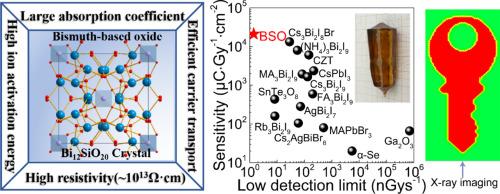“All three in one”: An excellent bismuth-based oxide hard X-ray detector unveiling ultra-high sensitivity, ultra-low dark current and ultra-low detection limit
IF 22
1区 材料科学
Q1 MATERIALS SCIENCE, MULTIDISCIPLINARY
引用次数: 0
Abstract
Currently, ongoing endeavors are under way for developing X-ray detection materials with high sensitivity and low detection limit used for medical diagnosis, industrial inspection and beyond. Presenting a groundbreaking solution, we originally propose the utilization of bismuth-based oxide crystals for X-ray detection. Specifically, we highlight the exceptional capabilities of Bi12SiO20 (BSO) crystal as an exemplary oxide X-ray detector. Benefiting from its large absorption coefficient, high resistivity (2.5 × 1013 Ω·cm), high ion activation energy (1.5 eV) and excellent carrier transport property (μτ = 7.5 × 10-3 cm2·V−1), the BSO X-ray detector exhibits an ultrahigh sensitivity of 2.1 × 104 μC·Gy−1·cm−2 under 120 keV hard X-ray, surpassing all previously reported all-inorganic bismuth-based perovskites materials. The specific detectivity (9.91 × 108 μC·Gy−1·cm−1·A-1/2) outperforms all known perovskite materials. Notably, the BSO X-ray detector achieves an ultralow detection limit of 1.4 nGys−1 owing to its low dark current (0.85 nA/cm2 at 10000 V/cm). These achievements not only establish BSO as an excellent hard X-ray detection material, but also pave a new avenue for exploring high-performance X-ray detectors within bismuth-based oxide crystals.

“三合一”:一种出色的铋基氧化物硬x射线探测器,揭示了超高灵敏度,超低暗电流和超低检测极限
目前,正在努力开发用于医疗诊断、工业检查等领域的高灵敏度、低检测限的x射线检测材料。提出了一个突破性的解决方案,我们最初提出利用铋基氧化物晶体进行x射线检测。具体来说,我们强调了Bi12SiO20 (BSO)晶体作为典型氧化物x射线探测器的卓越能力。由于吸收系数大、电阻率高(2.5 × 1013 Ω·cm)、离子活化能高(1.5 eV)和载流子输运性能优异(μτ = 7.5 × 10-3 cm2·V - 1), BSO x射线探测器在120 keV硬x射线下具有2.1 × 104 μC·Gy - 1·cm - 2的超高灵敏度,超越了以往报道的所有全无机铋基钙钛矿材料。比探测率(9.91 × 108 μC·Gy−1·cm−1·A-1/2)优于所有已知的钙钛矿材料。值得注意的是,BSO x射线探测器由于其低暗电流(在10000 V/cm时为0.85 nA/cm2)而达到了1.4 nGys−1的超低检测极限。这些成果不仅确立了BSO作为一种优秀的硬x射线探测材料的地位,而且为探索铋基氧化物晶体内的高性能x射线探测器铺平了新的道路。
本文章由计算机程序翻译,如有差异,请以英文原文为准。
求助全文
约1分钟内获得全文
求助全文
来源期刊

Materials Today
工程技术-材料科学:综合
CiteScore
36.30
自引率
1.20%
发文量
237
审稿时长
23 days
期刊介绍:
Materials Today is the leading journal in the Materials Today family, focusing on the latest and most impactful work in the materials science community. With a reputation for excellence in news and reviews, the journal has now expanded its coverage to include original research and aims to be at the forefront of the field.
We welcome comprehensive articles, short communications, and review articles from established leaders in the rapidly evolving fields of materials science and related disciplines. We strive to provide authors with rigorous peer review, fast publication, and maximum exposure for their work. While we only accept the most significant manuscripts, our speedy evaluation process ensures that there are no unnecessary publication delays.
 求助内容:
求助内容: 应助结果提醒方式:
应助结果提醒方式:


